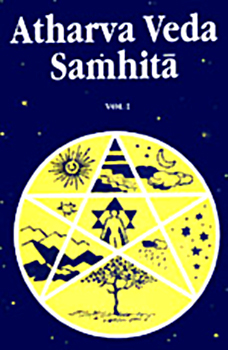 Songs and charms for sacrificial purposes are included in the later chapters of the Atharva Veda Samhita. These hymns were probably were included in the Atharva Veda only in order that the latter, like the other three Vedas, might be brought into connection with the sacrifice and be recognised as a real Veda. Thus, for example, we find two April hymns and other songs corresponding to the sacrificial chants of the Rig Veda. Prose formulae, too, which correspond to those of the Yajur Veda, are to be found. Instances of the same can be found in Book XVI of the Atharva Veda where the entire first half of which consists of formulae in which water is glorified, and which refer to some purification-ritual or other.
Songs and charms for sacrificial purposes are included in the later chapters of the Atharva Veda Samhita. These hymns were probably were included in the Atharva Veda only in order that the latter, like the other three Vedas, might be brought into connection with the sacrifice and be recognised as a real Veda. Thus, for example, we find two April hymns and other songs corresponding to the sacrificial chants of the Rig Veda. Prose formulae, too, which correspond to those of the Yajur Veda, are to be found. Instances of the same can be found in Book XVI of the Atharva Veda where the entire first half of which consists of formulae in which water is glorified, and which refer to some purification-ritual or other.
Book XVIII of the Atharva Veda, which contains the prayers pertaining to the death ritual and to ancestor-worship, should be included among this class of hymns. The funeral songs of Book X of the Rig Veda recur here literally, though they are increased by many additions. Also Book XX, which was added quite late, and the hymns of which, with few exceptions, are all borrowed from the Rig Veda, is related to the Soma-sacrifice.
The only new hymns in this book are the very curious "Kantapa hymns," contained in Atharva Veda XX, 127-136. They, too form part of the sacrificial ritual as liturgies, while in content they coincide partly with the Danastutis of the Rig Veda, praising the liberality of certain princes. They are partly in the form of riddles and their solutions, though there are also some which are actually obscene songs and coarse jokes. At certain sacrifices, which lasted for many days, hymns of this kind constituted the prescribed conversation of the priests.
These therefore are the songs and charms of sacrificial purposes contained in the Atharva Veda, similar and mostly lifted from the hymns of the Rig Veda.
This article is a stub. You can enrich by adding more information to it. Send your Write Up to content@indianetzone.com













